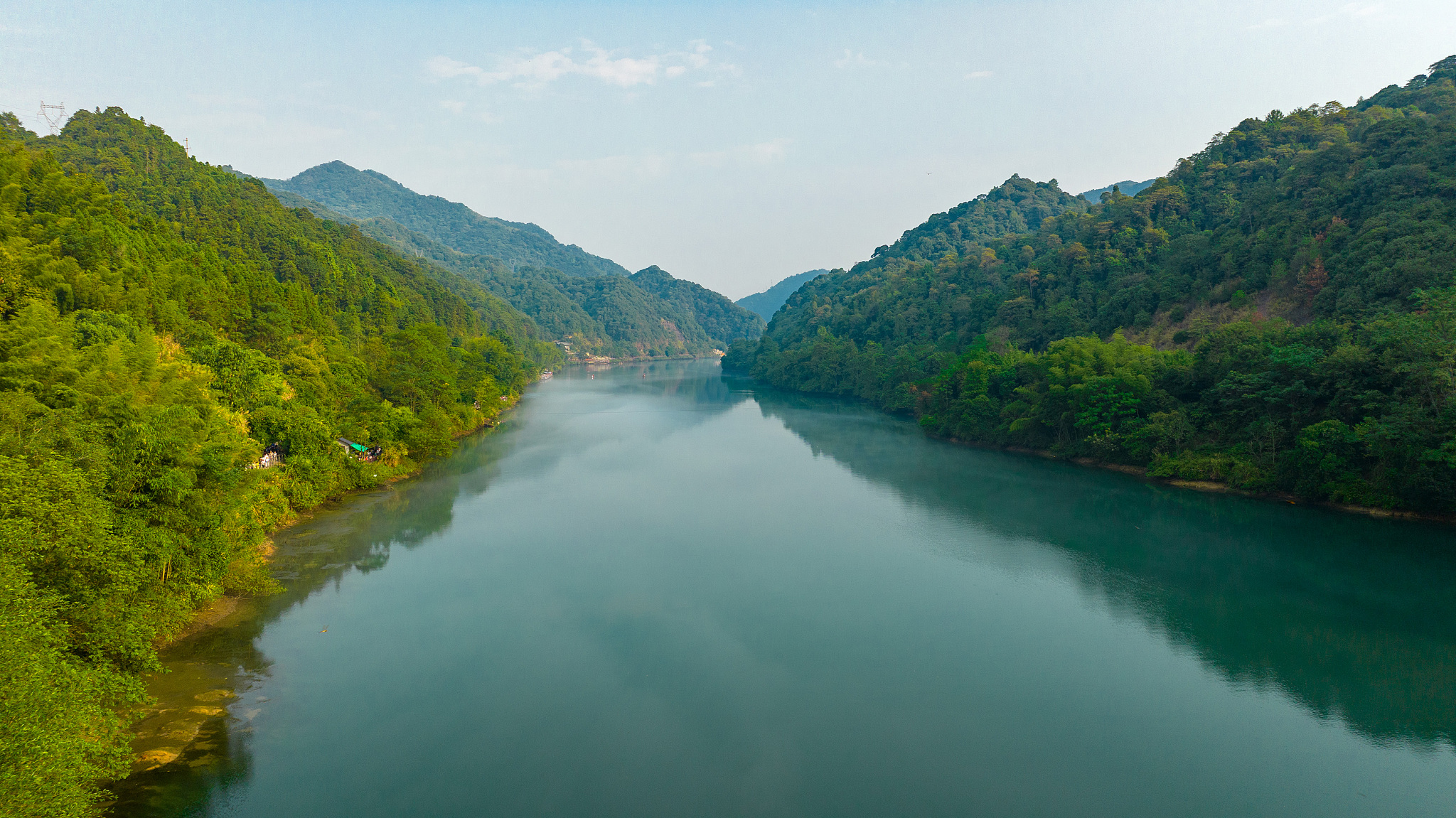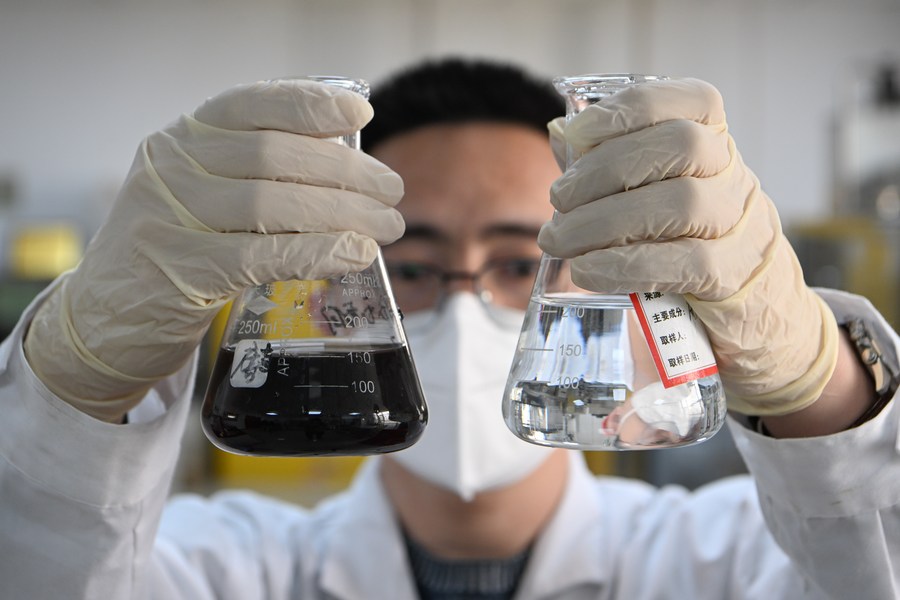
Dongjiang Lake in Chenzhou City, central China's Hunan Province, September 18, 2022. /CFP
Dongjiang Lake in Chenzhou City, central China's Hunan Province, September 18, 2022. /CFP
Chenzhou City, situated in central China's Hunan Province, has long been a hub for non-ferrous metals production due to its rich mineral resources. However, unchecked historical mining activities have severely damaged the region's water resources.
In recent years, the local government has been working on the ecological restoration of rivers in mining areas by using cutting-edge technology for heavy metal sewage treatment.
"It used to be that there was no grass growing on both sides of the riverbank. Now the water is so clear, and the banks are adorned with flowers," said a local resident.
Making the water clearer
Chenzhou is an example of China's efforts in improving the condition of its rivers and lakes. In 2022, the country's good-quality surface water, classified Grade III or higher in the country's five-tier system, accounted for 87.9 percent of the total.
China has also taken measures to combat water and soil erosion. The Yellow River, a vital waterway in northern China, has discharged a total of 2.71 billion tonnes of sediment since 2002 when the Xiaolangdi Reservoir began regulating water and sediment flow.
As a result, the minimum flow capacity of the main river channel has surged from 1,800 cubic meters per second to 5,000 cubic meters per second. This has effectively restored and upheld the flood capacity of the downstream river channel, changing the history patterns of riverbed sedimentation and elevation.
Through comprehensive water resource management, the Yellow River's mainstream has now achieved 24 consecutive years of continuous flow, ensuring a stable water supply for the livelihoods, industries, and agriculture of communities on both sides of the river.
The management of the Yellow River has lasted for centuries. Now the focus is on promoting the harmonious coexistence of people, the river and the ecosystem, said Professor Philippe Gourbesville, president of the International Association for Hydro-Environment Engineering and Research.

Scenery along the Yellow River in Maqu County, Gannan Tibetan Autonomous Prefecture of northwest China's Gansu Province, July 6, 2023. /Xinhua
Scenery along the Yellow River in Maqu County, Gannan Tibetan Autonomous Prefecture of northwest China's Gansu Province, July 6, 2023. /Xinhua
Meanwhile, the Yangtze River, the longest river in both China and Asia, has also witnessed improvement in its ecological environment. Major hydroelectric dams such as the Three Gorges and Baihetan have been constructed along the Yangtze to manage floods and generate a consistent source of clean energy for the country.
Over the past decades, the soil and water conservation rate within the Yangtze River Basin has climbed from 78.6 percent to 81.4 percent, an increase of 2.8 percentage points, according to the Ministry of Water Resources.
Improving management of water resources
Despite its limited water resources, China manages to provide water for nearly 20 percent of the world's population using just 6 percent of the global freshwater supply. Presently, 870 million people in rural China have access to safe drinking water.
Up to now, a total of 6.78 million rural water supply projects have been built across the country, and the rural tap water penetration rate is close to 88 percent, according to the Ministry of Water Resources.
In urban areas, the use of reclaimed water is crucial for mitigating water shortages. Commonly defined as treated municipal wastewater that is able to be used again, reclaimed water can be used for urban greening, sanitation, toilet flushing and industrial operations.
In Tianjin, one of the largest cities in northern China facing water scarcity, residents can purchase reclaimed water at half the price of tap water. The cost advantage has led residents to widely adopt reclaimed water for their daily needs.
Over the last two decades, Tianjin has expanded its network of reclaimed water pipelines. Apart from high water-consuming industries like thermal power and steel, this network serves 213 residential areas in the main city zone, over 230 business establishments, and 10 million square meters of public green spaces.
As the number of users and reclaimed water usage has grown, the government has shifted the responsibility for managing reclaimed water to enterprises, fostering market-oriented operations. Remarkably, Tianjin has maintained a reclaimed water price that remains at half the cost of tap water for many years."

A researcher displays industrial wastewater and processed recycled water at the National Research Center of Industrial Water Treatment Engineering and Technology in north China's Tianjin, March 22, 2023. /Xinhua
A researcher displays industrial wastewater and processed recycled water at the National Research Center of Industrial Water Treatment Engineering and Technology in north China's Tianjin, March 22, 2023. /Xinhua
Nationwide, China has seen a rise in its annual consumption of unconventional water resources, including reclaimed and desalinated water. In 2022, the total annual consumption of unconventional water resources reached 17.58 billion cubic meters, marking a 37 percent increase compared to 2020, according to the Ministry of Water Resources.
Recycling treated sewage to address the water crisis has become a common practice around the world, as many places are lacking water resources. According to the 2023 United Nations World Water Development Report, 2 billion people, or 26 percent of the population, lack access to safe drinking water globally.
In a world grappling with water scarcity, safeguarding and judiciously using water resources is a shared responsibility for all nations, according to the Beijing Declaration that was issued during the just-concluded 18th World Water Congress.
"China has a well-established track record in water resource management, spanning both local and national levels. This experience encompasses water projects, innovative techniques, and effective social management of water resources," Professor Philippe Gourbesville told China Media Group.
"I believe China is well-positioned to share this valuable expertise on the global stage and disseminate the successful innovative technologies that are emerging within the country," he added.